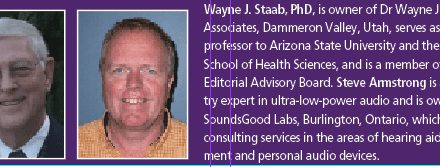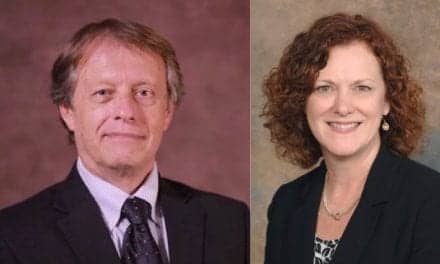The American Tinnitus Association is working to raise awareness of a condition that affects as many as 50 million Americans.

The 501(c)(3) nonprofit organization was founded in 1971 by Charles Unice, MD. A sufferer of tinnitus, Unice set up the ATA primarily as a research-funding organization, with a goal of giving $500,000 a year in research grants. To date, the ATA has funded about $2 million in research projects.
About 92% of the ATA’s $1.4 million budget comes from individuals with the balance coming from foundations (5%), corporations (2%), and bequests (1%). McGinnis hopes that in future the ATA will become less dependent on its membership and get a larger proportion of funding from other sources. However, many of the corporate and foundation gifts come in because of individual donors recommending that the ATA be funded.

Membership in the ATA costs $35 per year for which the subscriber receives the group’s journal, a discount on association products, and access to the members-only section of the Web site. Most of the members have felt the effects of tinnitus personally. “There’s some formal direct attachment to tinnitus whether these individuals are spouses or children of people who experience tinnitus, or they experience tinnitus themselves,” says McGinnis. “The majority experience tinnitus themselves. We do have professionals who are member donors of our organization. Many of them experience tinnitus, but they have an interest in serving the tinnitus community, which we are very pleased [about].”
Every year the ATA funds several $100,000 grants for research relating to a cure for tinnitus. And though there is yet to be an effective cure, there is growing interest in the research community about tinnitus.

Promising Research
The increased interest in tinnitus research is due in part to the ATA grants, says Richard Tyler, PhD, a member of the association’s scientific advisory committee. “The [ATA’s] provision of additional support increases the number of investigators interested in tinnitus,” he says. “Probably 15 years ago. there were only five or six groups around the world that were interested in tinnitus. Now there probably are 20 or 30 groups interested in pursuing research on tinnitus. Because the ATA is offering grants of $100,000 a year, now lots of people are paying attention to the American Tinnitus Association and tinnitus in general and trying to determine if their knowledge about cell biology or genetics or electrophysiology or psychology or attention can be applied to tinnitus; we’re attracting many people that would otherwise not be interested in the field of tinnitus research.”
The basic criterion for receiving a grant is that the research has to be innovative, which has meant that research projects have covered a wide array of fields. “It’s quite possible that one might be able to influence tinnitus perception by electrical stimulation,” says Tyler. “There’s been virtually no work in understanding the genes that might contribute to tinnitus. There is also some work using brain imaging techniques in patients who have tinnitus, but whose tinnitus may change as a function of time, or who can willfully change their tinnitus by altering their head posture, so pictures of their brain can be taken with and without tinnitus.”
Tyler, who is also a professor at the University of Iowa, Iowa City, knows a thing or two about innovative research. He is working on trying to devise therapies to manage tinnitus. “There are lots of people who have tinnitus who are not bothered by it, so one area of helping people with tinnitus [who are frustrated with their condition] is to move them into the group that have tinnitus and are not bothered,” he says. “Since most people who have tinnitus are not [annoyed] by it very much, that seems like a viable option. It may take us decades to find a ‘magic’ pill, and even if we do find a magic pill, it may not be helpful for everybody with tinnitus, because all the causes are different and the mechanisms are probably different. But it may very well be that we can help people manage their tinnitus. My research has been involved in trying to devise counseling strategies and sound therapy strategies to move people from one group to the other.”
The increased interest by researchers in the causes and effects of tinnitus have netted some breakthroughs, but no cures. “I think a major breakthrough has been the greater involvement of psychologists in the field,” says Tyler. “Some of the well-established psychological treatments that have been used to help people with pain and clinical depression have application in understanding and treating patients with tinnitus.” Among the contributions of psychologists have been several books that have outlined some treatment options, which Tyler calls “promising.”
|
Sounds You Live By Approximate Decibels (dB) |
|
|
|
|
|
|
But breakthroughs have not meant that research into tinnitus has not had roadblocks. One particular limitation is the lack of animal models at the researcher’s disposal. “If you’re doing research on heart disease, for instance, you can look at animals that might have heart disease and see if you can correct it, but with tinnitus it’s not so easy to know if an animal has that problem,” says Tyler. “So the use of animals to understand tinnitus is much more complicated. That’s been a major setback in the understanding and treatment of tinnitus.”
Though there has been no therapeutic magic pill, Tyler is optimistic about the future of tinnitus research. “We have come a long way in the last 20 years in the clinical application and the implementation of the knowledge,” he says. “I think that there are new clinical protocols being developed all the time. We’re in a much better position to understand and help patients than even 2 years ago. Instead of telling patients that they have to learn to live with it, we can help them and show them how to live with it.”
Research is not an end in itself. Tyler, for instance, couples it with education and a clear clinical application. “I think it’s essential, and certainly my interest has always been in taking what knowledge we learn in the laboratories and applying it directly to patient care,” he says.

Because there is no clear end in sight for the research, there are still many avenues that researchers are pursuing. “I think it would be a mistake to think there is one natural next step,” says Tyler. “I think that by keeping an open attitude on the different ways that tinnitus can be studied, we allow for the investigators to be innovative given their own knowledge and background. By keeping an open attitude from that perspective, I think we’re more likely to move forward more quickly, than if we focused on one particular area.”
Even though research is the fundamental mission of the ATA, there is much more that the organization does to help its members and all those who have tinnitus.
EARS
As an organization, the biggest challenge facing the ATA is building awareness about the condition and the ways to prevent it. To build awareness, the ATA has instituted its EARS programs, which focus on education, advocacy, research, and support.
Education involves putting on programs in schools, publishing the ATA’s quarterly journal, and brochures. In addition, McGinnis says that the ATA is beginning a professional course via the Internet that will allow users to earn continuing education units. The course is desperately needed. “We have received reports from tinnitus patients who lament the fact that they know more about tinnitus than their health care provider, and we would like to improve their experiences,” she says.
Advocacy involves monitoring public policies involving tinnitus and, when appropriate, issuing position statements. In many cases, the ATA finds itself among a chorus of voices supporting a particular position. “For example, there was a veterans hearing health act that was approved by both the Senate and the House, and now what they have mandated through the bill is to do further research so that compensation for individuals who have a military service-related hearing condition…can be addressed appropriately,” says McGinnis. “Currently, there is a bill that is a hearing aid assistance tax credit. It proposes that individuals 55 and older receive a $500 tax credit per hearing aid, also for any individual who purchases aids for a dependent. That has not come up for a vote yet, but we are in support of that legislation.” The ATA also helps tinnitus sufferers advocate on their own behalf.
Research involves supporting ways to treat and cure tinnitus with yearly grants (see above). Tyler is currently preparing a report for the quarterly journal that will detail the progress of the ATA-sponsored research.
DID YOU KNOW?
|
The ATA supports its members and other tinnitus sufferers through 40 support groups set up in 23 states. Led by hearing professionals or patients, these groups offer more than just one-on-one support. “Our support program also includes our provider resource list,” says McGinnis. “That list includes the hearing health care professionals who provide services to patients. On occasion, there have been tinnitus patients who have pursued legal restitution for their tinnitus, so there are some attorneys [whose services we list] and we have some counselors who provide services.”
Support also extends to the Web site. In addition to its regular monthly listserv, the ATA is planning to add live Internet chats to its support menu.
Awareness and support extend to professionals as well.
Helping Professionals
The ATA markets its message to various professional groups and individuals at trade shows and meetings held throughout the year. Its presentations have been growing in popularity. “There are more tinnitus presentations at the professional courses than there were just 3 years ago; in fact, the American Academy of Audiology has a tinnitus…track that is identified on its program schedule,” says McGinnis. “And the Association for Research in Otolaryngology had a half-day session in February 2003, and so those are ways we are reaching professionals.”
In many cases increasing awareness is not necessary because professionals are familiar with the problems related to tinnitus. What ATA can do then is offer ways for professionals to help their patients. “We have a brochure about our services that we offer in counts of 100 to any health care professional who wishes to make it available to their patients,” says McGinnis. “We can then serve as a resource to that professional and their patients. Many times the patients need more talk time. We do not provide advice from a medical or health care professional perspective.”
Even with all these support and awareness programs in place, the ATA has not stopped looking toward even bigger goals. This year, it piloted a tinnitus awareness day in Portland, and plans to take the event nationwide as a weeklong project by May of next year. It is all part of the general future goals of the organization. “We want to make tinnitus a known entity, not a known experience, but a condition that people are aware of and who then can make informed decisions to help prevent the condition,” says McGinnis.
Chris Wolski is associate editor of Hearing Products Report.





